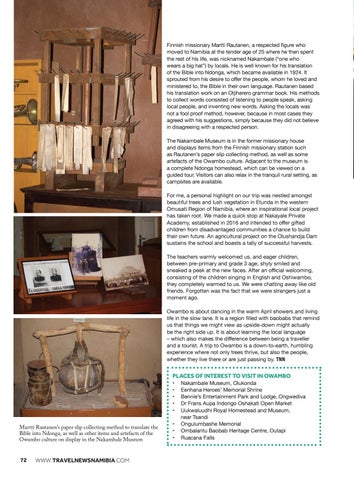Finnish missionary Martti Rautanen, a respected figure who moved to Namibia at the tender age of 25 where he then spent the rest of his life, was nicknamed Nakambale (“one who wears a big hat”) by locals. He is well known for his translation of the Bible into Ndonga, which became available in 1924. It sprouted from his desire to offer the people, whom he loved and ministered to, the Bible in their own language. Rautanen based his translation work on an Otjiherero grammar book. His methods to collect words consisted of listening to people speak, asking local people, and inventing new words. Asking the locals was not a fool proof method, however, because in most cases they agreed with his suggestions, simply because they did not believe in disagreeing with a respected person. The Nakambale Museum is in the former missionary house and displays items from the Finnish missionary station such as Rautanen’s paper slip collecting method, as well as some artefacts of the Owambo culture. Adjacent to the museum is a complete Ndonga homestead, which can be viewed on a guided tour. Visitors can also relax in the tranquil rural setting, as campsites are available. For me, a personal highlight on our trip was nestled amongst beautiful trees and lush vegetation in Etunda in the western Omusati Region of Namibia, where an inspirational local project has taken root. We made a quick stop at Nakayale Private Academy, established in 2016 and intended to offer gifted children from disadvantaged communities a chance to build their own future. An agricultural project on the Olushandja Dam sustains the school and boasts a tally of successful harvests. The teachers warmly welcomed us, and eager children, between pre-primary and grade 3 age, shyly smiled and sneaked a peek at the new faces. After an official welcoming, consisting of the children singing in English and Oshiwambo, they completely warmed to us. We were chatting away like old friends. Forgotten was the fact that we were strangers just a moment ago. Owambo is about dancing in the warm April showers and living life in the slow lane. It is a region filled with baobabs that remind us that things we might view as upside-down might actually be the right side up. It is about learning the local language – which also makes the difference between being a traveller and a tourist. A trip to Owambo is a down-to-earth, humbling experience where not only trees thrive, but also the people, whether they live there or are just passing by. TNN
PLACES OF INTEREST TO VISIT IN OWAMBO • • • • •
Martti Rautanen’s paper slip collecting method to translate the Bible into Ndonga, as well as other items and artefacts of the Owambo culture on display in the Nakambale Museum
72
WWW.TRAVELNEWSNAMIBIA.COM
Nakambale Museum, Olukonda Eenhana Heroes’ Memorial Shrine Bennie’s Entertainment Park and Lodge, Ongwediva Dr Frans Aupa Indongo Oshakati Open Market Uukwaluudhi Royal Homestead and Museum, near Tsandi • Ongulumbashe Memorial • Ombalantu Baobab Heritage Centre, Outapi • Ruacana Falls
